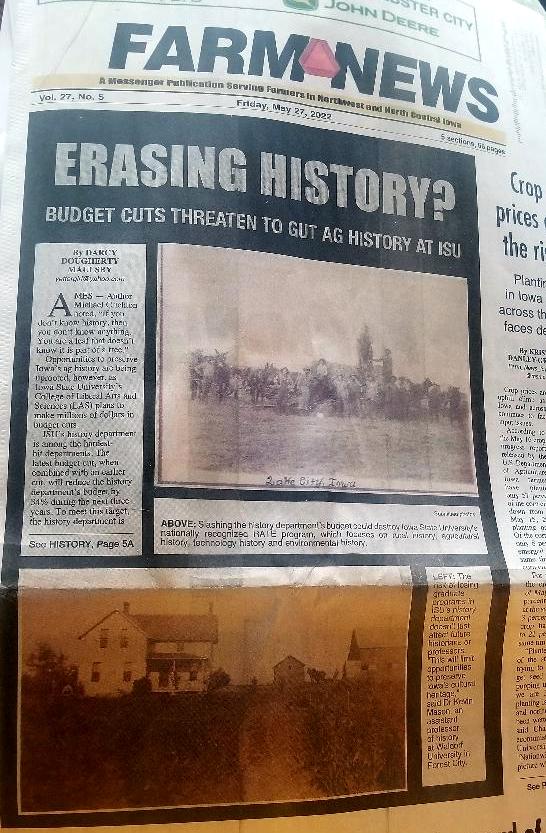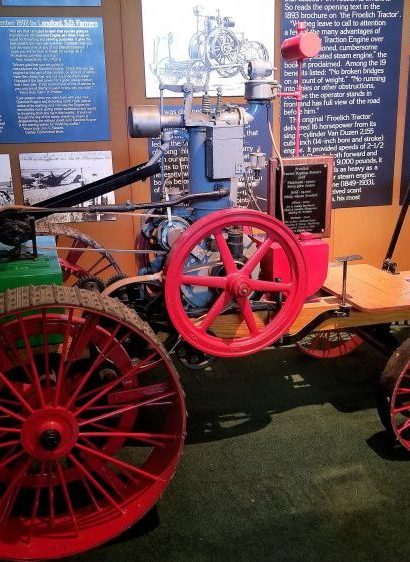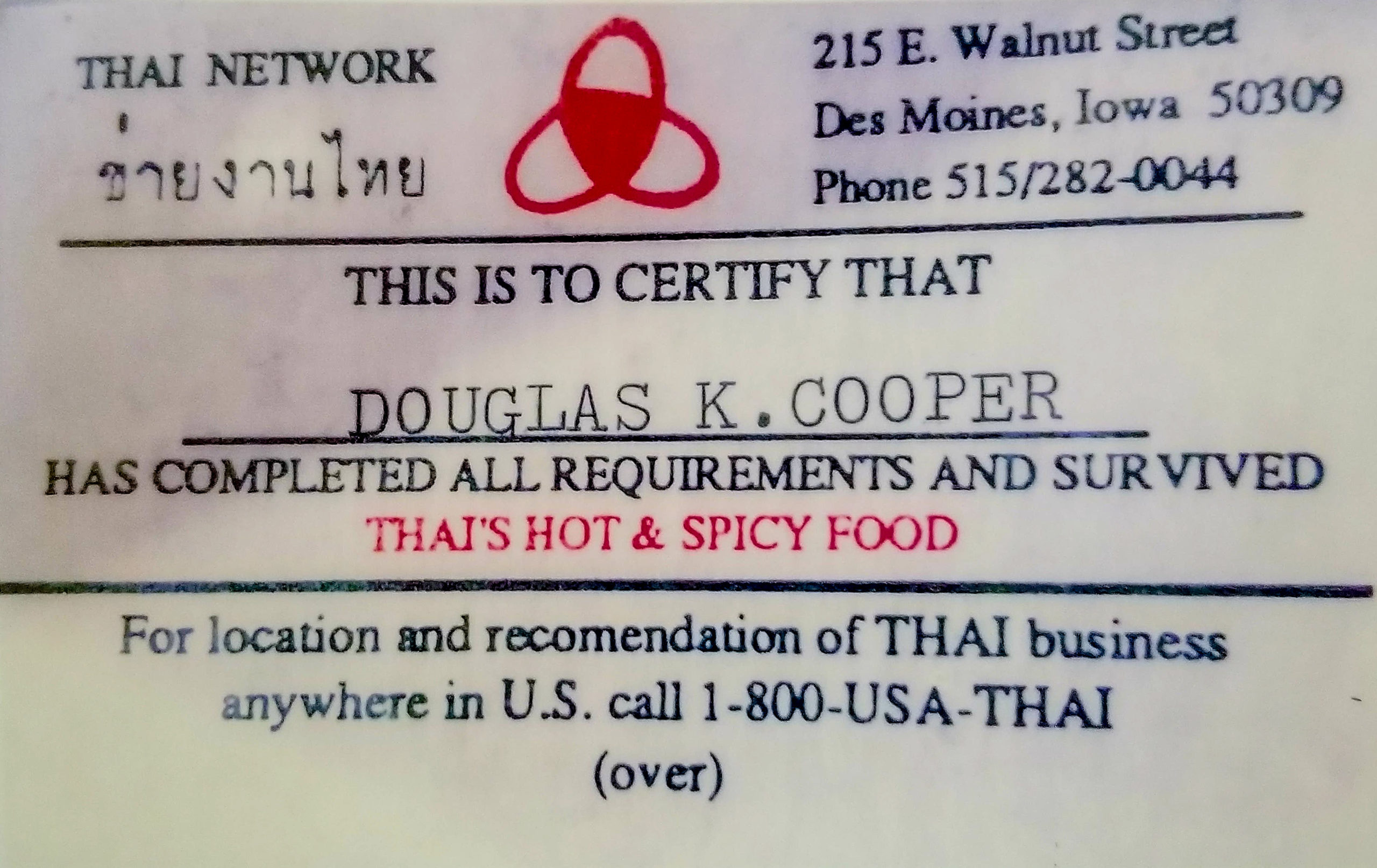
Whats HOT
Latest Posts

Could Your Story Change Someone’s Life?
Are you a gambler? I’m not. I’ve never even bought a lottery ticket. Maybe it’s because I grew up on a farm. (I learned early on that farming is enough of a gamble—no casino needed!)
Perhaps that’s why I wasn’t listening too closely to a discussion on talk radio recently about online sports betting. It’s a sure bet that sports wagering will be debated this year in the Iowa Capitol.
I was listening to show off and on as I wrote a question-and-answer feature about how FFA influenced Iowa Secretary of Agriculture Mike Naig’s career. The gambling debate wasn’t on my mind—until a story suddenly broke through and froze my fingers on the keyboard.
The radio show’s guest, Tom Coates, told the story of a woman who had called his family’s business, Consumer Credit of Des Moines, when she was caught in the strangling grip of a gambling addiction. Her ordeal had become so overwhelming, so costly and so shameful that she felt she was out of options—other than ending it all.
When she was driving home one night, she decided this was it. She was going to crash her car and end her life. For someone so consumed with despair, it made sense to her.
It just so happened that she had her car radio on during that fateful trip, however. A commercial from Consumer Credit caught her attention. Through a combination of the right message delivered in the right channel at the right time to the right audience, this simple ad (and maybe a serious jolt of divine intervention), stopped this woman from following through with her deadly plan.
She drove to a nearby gas station (this was in the days before everyone had a cell phone) and called Consumer Credit, Iowa’s largest credit counseling service. Consumer Credit’s message of helping people in financial trouble solve their debt problems touched something deep inside her. By dialing the phone, she received the help she needed.
Thanks to a simple radio ad, this woman’s story had a much happier outcome than it could have.
Cutting through the clutter–4 key takeaways
While the stakes usually aren’t this high with most messages we share, that doesn’t mean our stories don’t matter. You will cut through the clutter of this noisy world when you 1.) add value by offering a solution for your audience, 2.) speak human, 3.) strike an emotional chord, and 4.) share your stories consistently through a variety of channels.
You just never know which story or which communication method will connect with the people you’re trying to reach. That’s why it pays to try a variety of formats, from online channels to print publications to audio or video.
Will you be top of mind when someone needs to hear your story? Never underestimate the power of a true story well told. Your story might just matter to someone more than you know.
Want more?
Thanks for stopping by. I invite you to read more of my blog posts if you value intriguing Iowa stories and history, along with Iowa food, agriculture updates, recipes and tips to make you a better communicator.
If you like what you see and want to be notified when I post new stories, be sure to click on the “subscribe to blog updates/newsletter” button at the top of this page, or click here. Feel free to share this with friends and colleagues who might be interested, too.
Also, if you or someone you know could use my writing services (I’m not only Iowa’s storyteller, but a professionally-trained journalist with 20 years of experience), let’s talk. I work with businesses and organizations within Iowa and across the country to unleash the power of great storytelling to define their brand and connect with their audience through clear, compelling blog posts, articles, news releases, feature stories, newsletter articles, social media, video scripts, and photography. Learn more at www.darcymaulsby.com, or e-mail me at yettergirl@yahoo.com.
If you’re hungry for more stories of Iowa history, check out my top-selling “Culinary History of Iowa: Sweet Corn, Pork Tenderloins, Maid-Rites and More” book from The History Press. Also take a look at my latest book, “Dallas County,” and my Calhoun County” book from Arcadia Publishing. Both are filled with vintage photos and compelling stories that showcase he history of small-town and rural Iowa. Order your signed copies today! Iowa postcards are available in my online store, too.
Let’s stay in touch. I’m at darcy@darcymaulsby.com, and yettergirl@yahoo.com.
Talk to you soon!
Darcy
@Copyright 2019 Darcy Maulsby & Co. Blog posts may only be reprinted with permission from Darcy Maulsby.

4 Key Lessons from Bud Light’s Super Bowl Corn-troversy
What a difference a day makes. Last Saturday, Feb. 2, I was in Altoona, Iowa, teaching my “Harvest Meals Made Easy” class at the Iowa Farm Bureau’s annual Young Farmer Conference. When I shared my three-ingredient recipe for the tastiest, simplest beer bread around, I noted that the type of beer you use isn’t a big deal, although the friend who shared the recipe with me preferred Bud Light.
Since I’m not much of a beer drinker, I didn’t give Bud Light another thought –until I was watching the Super Bowl last Sunday night.
I tuned in for two main reasons—1.) I’m a Tom Brady fan (see my blog post “Can a True Story Well Told Turn You into a Tom Brady Fan?), and 2.) as a marketer, I like to watch the commercials. I was less than impressed with most of the commercials (you paid more than $5 million for a 30-second spot and only came up with THAT???), although I loved the Microsoft ad “We All Win,” With a story revolving around a young boy from Texas, the ad showcased how Microsoft’s Xbox Adaptive Controller helps children with disabilities enjoy gaming. (This inspiring ad, which nearly brought tears to my eyes, topped the list of “most effective” ads with an UnrulyEQ score of 7.5, according to Ad Week.)
One ad that didn’t impress me was Bud Light’s slam against corn syrup. The ad emphasized that Bud Light doesn’t use corn syrup like competitors’ beers do. I thought it was an odd approach to advertise a mass-produced beer. It also ticked me off, since my family grows corn on our Century Farm, but I figured the stupid ad would just fade away into the wasteland of unremarkable, lame marketing.
I was wrong.
Bud Light versus…corn farmers?
Since I always like to hear what others think about these things, I tuned into the radio when I was headed to Ames the morning after the Super Bowl to attend a soil health conference. The general consensus on talk-radio was that the big game was boring (it was the lowest-scoring game in Super Bowl history), and most of the commercials were boring. No one on those shows was talking about the Bud Light commercial—yet.
But then the story exploded.
One of the first volleys in the battle came when my friend Kevin Ross, a farmer from Minden, Iowa, filmed a 9-second video and posted it to Twitter. As he dumped a can of Bud Light down the bathroom sink, he said, “Bud Light, you’re not standing with corn farmers. We’re not standing with you.”
That simple video helped unleash a media firestorm that led to coverage not only in Iowa media outlets, but Fox Business and other national media organizations. The day after the Super Bowl, the New York Times ran the article, “Bud Light Picks Fight with Corn Syrup in Super Bowl Ad.”
In the Feb. 4 story, Wendy Clark, chief executive of the advertising agency DDB Worldwide, noted that the back-and-forth spat may not have been the best result for Bud Light.
“I don’t know if anyone watching the Super Bowl necessarily cares about corn syrup, and it kicked up much ado about nothing,” Ms. Clark said. “It’s taken off into this corn syrup thing and not a Bud Light thing,” she added, “and I don’t know if that was the goal.”
What were they thinking?
I had to agree as I looked at this not as a farmer, but a storyteller who helps business leaders become thought leaders, attract skilled talent, appeal to more prospects and customers, and drive sales, one story at a time.
A cardinal rule of sharing true stories well told? Know your audience.
Back to Bud Light. Does anyone watching the Super Bowl care that much about corn syrup?
I thought about people I know who drink Bud Light. They tend to be hard-working, middle-class, patriotic Americans who just like to relax at the end of the day with an affordable, refreshing cold beer. They are not worried about corn syrup or health concerns related to excess corn syrup, especially when it comes to beer.
Is Bud Light really that clueless about its consumers?
Or are current Bud Light drinkers really the target audience for Bud Light’s advertisements?
Digging into the story behind the data
The question spurred me to investigate what research reveals about the typical Bud Light drinker.
According to InfoScout.com, which gathers consumer insights and demographics, Bud Light consumers are generally lower income, Hispanic and older. It appears that “older” is the key word that applies not just to Bud Light, but Budweiser, too. A Time.com article in 2014 noted that almost half of millennials had never drunk a Budweiser.
“The flagship Budweiser beer remains popular mostly among older folks, and its parent company, Anheuser-Busch InBev, is refocusing its marketing specifically on the millennial age bracket, the Wall Street Journal reports.”
Dazed and confused
Ahhhhh. I began to suspect what’s going on with the Bud Light corn syrup ad is a classic brand struggling to reinvent itself in a beer market that’s changing fast.
The stakes are high. Consider the 2018 Fortune.com article “Americans Are No Longer Drinking Budweiser and Bud Light Beers Like They Once Did,” which noted that sales of domestic lagers have receded as American consumers turn to craft beers, Mexican imports, wine and spirits to get their buzz.
In July 2018, Anheuser-Busch InBev (which manufactures Budweiser and Bud Light) reported that U.S. revenues fell 3.1 percent in the second quarter. The underperformance resulted in the company missing overall sales growth forecasts, triggering shares to drop more than 5 percent.
What’s going on?
Part of the challenge comes from millennials, who make up a sizeable percentage of legal beer consumers in America today. Millennials are the most skeptical generation in history when it comes to advertising. In an advertising-saturated world, this distrust in marketing hype means authenticity is a driving factor for millennials.
Hence the meteoric rise of craft beer, which is infused with authenticity. Compelling stories of local brewers who combine unique ingredients to brew beer in repurposed historical buildings that become hubs of the community capture the imagination—and beer drinkers’ dollars.
While overall U.S. beer volume sales were down 1 percent in 2017, according to the Brewers Association, craft brewer sales bucked the trend.
• Craft beers continued to grow at a rate of 5 percent by volume, reaching 12.7 percent of the U.S. beer market by volume.
• Retail dollar sales of craft increased 8 percent, up to $26 billion.
• Craft beers now account for more than 23% of the $111.4 billion U.S. beer market.
With all these challenges facing traditional brewers, what’s Bud Light to do? A corn syrup-focused ad during the big game clearly wasn’t the answer.
Backlash in the beer war
My friend Kevin, the corn farmer who serves as first vice president of the National Corn Growers Association, told Yahoo Finance the Bud Light ad “implied that [corn syrup] was an inferior product and that the other beers were doing something wrong because they use corn syrup in the brewing process,” and called it an “attack.”
Miller Lite took out a full-page ad in the New York Times on Feb. 6, stating in part, “The ‘corn syrup’ we source from America’s heartland helps make Miller Lite taste so great… It’s unfortunate that our competitor’s Big Game ad created an unnecessary #corntroversy.”
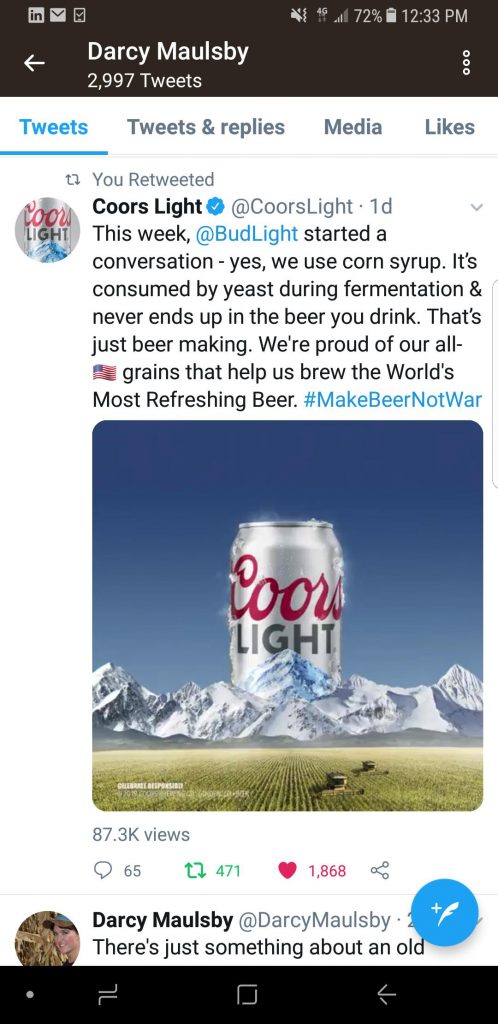 Also on Feb. 6, Coors Light tweeted, “This week, Bud Light started a conversation –yes, we use corn syrup. It’s consumed by yeast during fermentation & never ends up in the beer you drink. That’s just beer making. We’re proud of our all-American grains that help us brew the World’s Most Refreshing Beer. #MakeBeerNotWar”
Also on Feb. 6, Coors Light tweeted, “This week, Bud Light started a conversation –yes, we use corn syrup. It’s consumed by yeast during fermentation & never ends up in the beer you drink. That’s just beer making. We’re proud of our all-American grains that help us brew the World’s Most Refreshing Beer. #MakeBeerNotWar”
It didn’t take long before Bud Light began backtracking. In a tweet on Feb. 6, presented as a note from the king character from the ad, Bud Light said, “Yeesh! That escalated quickly… In the Bud Light Kingdom we love corn too! Corn on the cob, corn bread, popcorn—we just don’t brew with the syrup (what you also call ‘dextrose’).”
I’ll drink to that
So what can we take away from the Bud Light corn-troversy?
1. Know your audience.
2. Authenticity matters.
3. You don’t control your message, especially in a world of social media.
4. Instead of contrived marketing hype, tap into the power of true stories well told.
Want more?
Thanks for stopping by. I invite you to read more of my blog posts if you value intriguing Iowa stories and history, along with Iowa food, agriculture updates, recipes and tips to make you a better communicator.
If you like what you see and want to be notified when I post new stories, be sure to click on the “subscribe to blog updates/newsletter” button at the top of this page, or click here. Feel free to share this with friends and colleagues who might be interested, too.
Also, if you or someone you know could use my writing services (I’m not only Iowa’s storyteller, but a professionally-trained journalist with 20 years of experience), let’s talk. I work with businesses and organizations within Iowa and across the country to unleash the power of great storytelling to define their brand and connect with their audience through clear, compelling blog posts, articles, news releases, feature stories, newsletter articles, social media, video scripts, and photography. Learn more at www.darcymaulsby.com, or e-mail me at yettergirl@yahoo.com.
If you’re hungry for more stories of Iowa history, check out my top-selling “Culinary History of Iowa: Sweet Corn, Pork Tenderloins, Maid-Rites and More” book from The History Press. Also take a look at my latest book, “Dallas County,” and my Calhoun County” book from Arcadia Publishing. Both are filled with vintage photos and compelling stories that showcase he history of small-town and rural Iowa. Order your signed copies today! Iowa postcards are available in my online store, too.
Let’s stay in touch. I’m at darcy@darcymaulsby.com, and yettergirl@yahoo.com.
Talk to you soon!
Darcy
@Copyright 2019 Darcy Maulsby & Co. Blog posts may only be reprinted with permission from Darcy Maulsby.
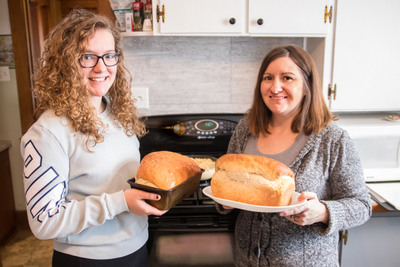
Baking is for Sharing: Best Bread, Grandma Ruby’s Cookies and Other Iowa Favorites
One of the most fun projects I write for clients is the Farm Cook feature that appears in Farm News. I get to meet interesting people in my area and fine-tune my culinary skills, thanks to the wonderful recipes and handy cooking tips they share. Here’s my latest Farm Cook feature with my new friend, Valerie. Enjoy!
What is it about baking that’s so intensely satisfying? Is it the rich aromas, the magic of creating something so comforting, or the opportunity to make family mealtime a priority? It’s all the above for Valerie Stuhrenberg of Pocahontas.
“I’ve always liked to cook and bake,” said Stuhrenberg, a Pocahontas native and registered nurse who works at Stewart Memorial Community Hospital in Lake City. “It runs in the family.”
Stuhrenberg, the youngest of 10 children, credits her father, Keith, with inspiring her love of cooking and baking. While his famous homemade cinnamon rolls were the hit of the neighborhood, Stuhrenberg especially loved his homemade pancakes.
“Dad learned to cook from his Grandma Stanton, who lived in Peterson,” said Stuhrenberg, who noted that he honed his culinary skills in various restaurants, including the Green Lantern Steak House in Decatur, Nebraska, and a restaurant he ran in Rockwell City.
Like many good cooks, Stuhrenberg’s father came from a line of home cooks who didn’t rely much, if at all, on recipes. This tradition of experimenting in the kitchen was passed on to Stuhrenberg, who’s not afraid of a challenge. When a friend who moved to Iowa asked if Stuhrenberg could make her a Kentucky Jam Cake, she wasn’t daunted.
“I said sure, even though I’d never heard of it before,” said Stuhrenberg, who had no trouble making this frosted spice cake.
Stuhrenberg has passed along her love of baking to her daughter, Ally, 14, a freshman at Pocahontas Area High School. When she was a member of the Guys and Gals of Grant 4-H Club, Ally Stuhrenberg’s baked goods, including Kentucky Jam Cake, won top honors at both the Pocahontas County Fair and the Iowa State Fair.
There’s always something homemade and good to eat at home, added Ally Stuhrenberg, who helps cook for her dad, Bob, and younger brother, Trevor, when her mother is working. Home cooking abounds at family get-togethers, added Valerie Stuhrenberg, who noted that all her siblings can cook, and one brother is a chef in the Omaha area. “It makes holidays really fun.”
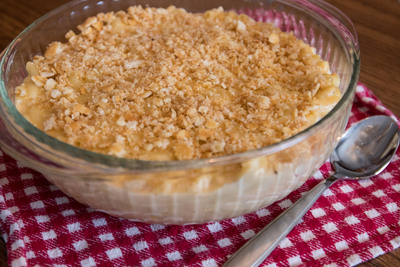
Homemade Baked Mac and Cheese
Baked Macaroni & Cheese
8 ounces elbow macaroni (2 cups dry macaroni)
4 tablespoons butter
4 tablespoons flour
1 / 2 teaspoon salt
Black pepper, to taste
1 / 4 teaspoon nutmeg
1 cup milk
1 cup cream or evaporated milk
2 cups cheddar cheese, shredded
Crumb topping:
Ritz crackers, crushed
Butter
Preheat oven to 400 degrees Fahrenheit. Cook macaroni, and set aside. Melt butter in a sauce pan. Whisk in the flour, salt, black pepper and nutmeg. Add milk and cream (or evaporated milk); boil for 2 minutes, stirring constantly. Turn down the heat, and simmer mixture for 10 minutes, stirring occasionally. Remove from heat.
Add cheese to cream sauce mixture. Combine with cooked elbow macaroni. Pour into baking dish and bake for 10 minutes. As the casserole bakes, combine crushed Ritz crackers and melted butter. (Stuhrenberg doesn’t measure exactly amounts.) After 10 minutes of baking, remove casserole from oven, sprinkle crumb topping mixture over the top, and bake the casserole for 10 more minutes. Remove from oven and serve.
(Note: all the ingredients, other than the crumb topping, can be combined and then frozen so the casserole can be baked later.)
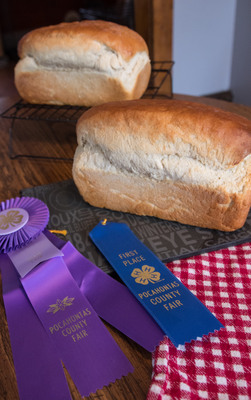
Award-winning Best Bread
Best Bread
4 1 / 2 teaspoons (2 packages) yeast
3 / 4 cup warm water
3 tablespoons soft butter
1 / 4 cup granulated sugar
1 tablespoon salt
2 2 / 3 cups additional water
9 to 10 cups flour
Put yeast and 3 / 4 cup warm water in mixer to proof for 5 minutes. Add butter, sugar, salt and the additional 2 2 / 3 cups water. Slowly add 5 cups of flour. Then add the remaining flour until a dough ball forms. Knead the dough for 5 to 10 minutes in mixer. (You may need to knead the dough in two batches.)
Put dough into a greased bowl, and let dough rise for 1 hour.
Punch down the dough, and separate the dough into two halves for two loaves of bread. Roll the dough out into two 12-inch by 12-inch squares. Then roll each square into the shape of a loaf of bread, tightly tucking in the seams and ends.
Place loaves in greased bread pans, and allow the dough to rise for 1 hour. Bake loaves for 15 minutes in an oven preheated to 425 degrees Fahrenheit. Cover loaves with aluminum foil, and bake 15 minutes more. Remove loaves from oven and cool on wire racks.
Grandma Ruby’s Cookies
This recipe came from Ruby Otto, a farm wife from the Plover area. “She would always make a big batch of these so she could take some to the field at planting and harvest and keep some in the freezer,” Valerie Stuhrenberg said.
2 cups granulated sugar
4 cups brown sugar
4 cups shortening
8 medium eggs
4 teaspoons vanilla
4 teaspoons baking soda
9 to 10 cups flour
2 teaspoons salt
24 ounces chocolate chips
24 ounces raisins
Preheat oven to 350 degrees Fahrenheit. Use an electric mixer to cream together the white sugar, brown sugar and shortening until smooth. Beat in the eggs one at a time, then stir in vanilla. In a separate bowl, combine the baking soda, salt and flour. Combine liquid mixture with dry mixture. Add chocolate chips and raisins to the batter.
Drop by large spoonfuls onto ungreased cookie sheets. Bake for about 10 to 13 minutes in the preheated oven, or until cookie edges are nicely browned. (More baking time creates a crisper cookie, while less baking time creates a chewier cookie.)
Kentucky Jam Cake with Caramel Frosting
Kentucky Jam Cake is a regional specialty. Instead of spreading the seedless blackberry jam between the cake layers, it is incorporated into the cake batter, along with a variety of spices, nuts and dried fruit. The moist, sweet, tangy cake is layered and covered with caramel frosting.
1 cup butter or margarine
2 cups granulated sugar
4 eggs
3 cups flour
1 teaspoon baking soda
1 teaspoon cinnamon
1 teaspoon nutmeg
1 teaspoon ground cloves
1 teaspoon ground allspice
1 cup buttermilk
1 teaspoon vanilla
1 cup of jam (seedless blackberry works well)
1 cup raisins
1 cup pecans, chopped
Cream butter and sugar. Beat in eggs, one at a time. In a separate bowl, sift all dry ingredients. Add the dry ingredients and buttermilk to the creamed mixture. (Alternate the addition of a portion of the dry mixture with a portion of buttermilk until all these ingredients have been incorporated into the batter.)
Add vanilla; mix well. Fold jam into cake batter. Add raisins and pecans; stir to combine.
Bake in two greased, floured baking pans for 35 to 45 minutes. Let cakes cool in pans for 15 minutes before turning the cakes onto waxed paper. Cool or freeze the cake before frosting with Caramel Frosting.
Caramel Frosting
2 1 / 4 cups brown sugar
1 1 / 2 sticks butter
2 tablespoons vanilla
3 tablespoons white corn syrup
4 1 / 2 tablespoons milk
2 1 / 4 cups confectioners’ sugar
Combine brown sugar, butter, vanilla, corn syrup and milk in a saucepan. Heat to melt the mixture. Remove mixture from heat; stir in confectioners’ sugar. Add sugar, as needed, until frosting has a glazed look and reaches the right spreading consistency. Spread frosting on the Kentucky Jam Cake quickly before the frosting hardens.
Black Magic Cake
1 3 / 4 cups all-purpose flour
2 cups granulated sugar
3 / 4 cup cocoa, unsweetened
2 teaspoons baking soda
1 teaspoon baking powder
1 teaspoon salt
2 large eggs
1 cup strong black coffee, cooled
1 cup buttermilk
1 / 2 cup vegetable oil
1 teaspoon vanilla extract
Combine flour, sugar, cocoa, baking soda, baking powder and salt in a large mixing bowl or stand mixer. Add eggs, coffee, buttermilk, vegetable oil and vanilla. Beat at medium speed for two minutes. Batter will be thin.
Pour batter into a greased and floured 9-inch by 13-inch pan, or two 9-inch round cake pans. Bake at 350 degrees for 35-40 minutes for a 9-inch by 13-inch pan, or 30-35 minutes for round pans. Remove cake from oven and cool. Spread with Easy Penuche Icing.
Easy Penuche Icing
1 / 2 cup butter
1 cup brown sugar, packed
1 / 4 cup milk
1 3 / 4 to 2 cups powdered sugar
Boil butter and brown sugar in saucepan for 2 minutes; remove from heat. Stir in milk. Mix in powdered sugar.
Want more?
Thanks for stopping by. I invite you to read more of my blog posts if you value intriguing Iowa stories and history, along with Iowa food, agriculture updates, recipes and tips to make you a better communicator.
If you like what you see and want to be notified when I post new stories, be sure to click on the “subscribe to blog updates/newsletter” button at the top of this page, or click here. Feel free to share this with friends and colleagues who might be interested, too.
Also, if you or someone you know could use my writing services (I’m not only Iowa’s storyteller, but a professionally-trained journalist with 20 years of experience), let’s talk. I work with businesses and organizations within Iowa and across the country to unleash the power of great storytelling to define their brand and connect with their audience through clear, compelling blog posts, articles, news releases, feature stories, newsletter articles, social media, video scripts, and photography. Learn more at www.darcymaulsby.com, or e-mail me at yettergirl@yahoo.com.
If you’re hungry for more stories of Iowa history, check out my top-selling “Culinary History of Iowa: Sweet Corn, Pork Tenderloins, Maid-Rites and More” book from The History Press. Also take a look at my latest book, “Dallas County,” and my Calhoun County” book from Arcadia Publishing. Both are filled with vintage photos and compelling stories that showcase he history of small-town and rural Iowa. Order your signed copies today! Iowa postcards are available in my online store, too.
Let’s stay in touch. I’m at darcy@darcymaulsby.com, and yettergirl@yahoo.com.
Talk to you soon!
Darcy
@Copyright 2019 Darcy Maulsby & Co. Blog posts may only be reprinted with permission from Darcy Maulsby.

Can a True Story Well Told Turn You into a Tom Brady Fan?
Ever had that experience where you thought you know someone well, and then something that person says or does throws you for a loop? It happened to me last week when one of my clients, who has also become one of my dear friends, brought up Tom Brady.
We were brainstorming story ideas for her company’s magazine when my friend turned the conversation to the New England Patriots’ quarterback. She became more animated as she talked about why Brady is such a great guy.
“You really need to watch this video,” says my friend, who texted me the link to the 47-minute documentary “The Brady 6 – The #199 Draft Pick Tom Brady Story.”
Sure, I knew the basics about Brady (good-looking guy, married to a supermodel, a father, an amazing athlete who has led his team to multiple Super Bowl victories—the kind of guy lots of people love to hate).
But my friend wouldn’t stop talking about Brady-and I was fascinated. This is a lady who admits she had no interest—zero—in football before she got hooked on Brady.
It wasn’t Brady’s looks, his athletic ability or his NFL statistics that captured her imagination. It was his story. This unlikely football fan couldn’t resist an underdog story defined by compelling characters, high stakes, uncertain outcomes and someone with the heart of a champion who never gives up.
“I like Tom Brady’s story so much that I saved the Brady 6 video and still watch it from time to time,” my friend confides to me.
I didn’t really know Brady’s back story, so I took my friend’s advice and watched the Brady 6 documentary. The Brady 6 refers to the 6 quarterbacks selected before Brady, who was the 199th pick overall in the 2000 NFL draft. The fact that no one saw his true potential during the NFL draft didn’t stop Brady from becoming one of the greatest quarterbacks of all time.
Brady is still on top of his game 19 years after being drafted. Now in his 40s, he’s doing things never seen before in the NFL. He’s still leading his team to Super Bowls, winning MVP awards, and doing it at an age when most quarterbacks have moved on to the TV booth or disappeared into obscurity.
All this is what transformed my friend into a Tom Brady fan who loves the Patriots’ football. “Every year I try to learn more about the game,” she says with so much passion and enthusiasm that I wonder if I’m really talking to this friend I thought I knew so well. Can this really be the lady who has had a successful 40-year career and starts thinking about retirement a little more each year? Who is this demure magazine editor-turned-football fan?
“So do you buy Patriots’ stuff?” I ask.
“Are you kidding? I have Patriots everything, from shirts to socks. I even made a point to go to Foxborough (Massachusetts) last fall for my first Patriots’ game when I was in New England for a journalism conference.”
She just couldn’t help herself. “Oh, that was great!” she exclaims. “It was just wonderful to be around all those Patriots fans—and the Patriots beat the Dolphins!”
My friend’s devotion hasn’t stopped with purchases of Patriots gear and game tickets. She has also downloaded the Patriots’ smartphone app to keep up with the team, and she listens to the Patriots’ radio show faithfully.
“And now I know a lot of stories of the other players, too,” she proclaimed. “I really love this team!”
I have to admit—because of my friend’s enthusiasm and her word-of-mouth marketing, I’ve become a Tom Brady fan, too, and will be cheering on the Patriots this Sunday.
What’s your Tom Brady story?
My friend’s Tom Brady story reminds me of a timeless marketing truth—never underestimate the power of a true story well told.
The best part is that we all have our own Tom Brady stories to tell. True stories of perseverance, excellence, overcoming adversity, and using our talents to make the world a more interesting, enjoyable place.
Are you trying to grow your customer base? Seeking more donations or volunteers to support your non-profit organization? Want to be perceived as a thought leader? Uncovering your unique stories, framing them in a way that resonates with your audience and sharing them can help you cut through the marketing clutter and stand out in the best possible way.
I’d love to help you discover and craft the stories that help you add value to your audience and make a positive difference in your world. Let’s start the conversation.
Oh—one more thing. Whether you watch the Super Bowl for the football or the commercials, enjoy the big game!
Want more?
Thanks for stopping by. I invite you to read more of my blog posts if you value intriguing Iowa stories and history, along with Iowa food, agriculture updates, recipes and tips to make you a better communicator.
If you like what you see and want to be notified when I post new stories, be sure to click on the “subscribe to blog updates/newsletter” button at the top of this page, or click here. Feel free to share this with friends and colleagues who might be interested, too.
Also, if you or someone you know could use my writing services (I’m not only Iowa’s storyteller, but a professionally-trained journalist with 20 years of experience), let’s talk. I work with businesses and organizations within Iowa and across the country to unleash the power of great storytelling to define their brand and connect with their audience through clear, compelling blog posts, articles, news releases, feature stories, newsletter articles, social media, video scripts, and photography. Learn more at www.darcymaulsby.com, or e-mail me at yettergirl@yahoo.com.
If you’re hungry for more stories of Iowa history, check out my top-selling “Culinary History of Iowa: Sweet Corn, Pork Tenderloins, Maid-Rites and More” book from The History Press. Also take a look at my latest book, “Dallas County,” and my Calhoun County” book from Arcadia Publishing. Both are filled with vintage photos and compelling stories that showcase he history of small-town and rural Iowa. Order your signed copies today! Iowa postcards are available in my online store, too.
Let’s stay in touch. I’m at darcy@darcymaulsby.com, and yettergirl@yahoo.com.
Talk to you soon!
Darcy
@Copyright 2019 Darcy Maulsby & Co. Blog posts may only be reprinted with permission from Darcy Maulsby.

Warm Up with Homemade Macaroni and Cheese Soup
It’s 10 degrees outside here in Iowa, the mercury is falling, it’s snowing, the wind is blowing, and I feel invincible—because I have a warm kettle of Mac and Cheese Soup on the stove.
“Soup puts the heart at ease, calms down the violence of hunger, eliminates the tension of the day, and awakens and refines the appetite,” noted Auguste Escoffier, the “chef of kings and king of chefs.”
I couldn’t agree more. Ask me my favorite thing to cook, and the answer is almost always soup. While I love proven recipes, I also like experimenting in the kitchen, like I did today. I made a batch of homemade macaroni and cheese a couple days ago that didn’t turn out quite as creamy as I wanted. I also had a small portion of leftover bacon mac and cheese from a recent meal at the Wild Rose Casino in Jefferson. What to do?
Hmmmm, could I combine these into mac and cheese soup? Is there such a thing as mac and cheese soup?
If not, let’s create it!
After a quick Google search for some culinary inspiration, I came up with a game plan. Since soup-making is more of an art than a science, I always tell people my recipes aren’t rules, just suggestions. You can reduce the milk if you like a thicker soup. Add more salt or pepper if you like. Enjoy a certain vegetable that’s not on the ingredient list? Try adding it. Do what makes sense to you.
A few cooking tips I do encourage:
• Use a pepper grinder to add fresh-ground pepper to your soup. I like to use a mix of red, black, green and white peppercorns for extra flavor.
• Do include the diced peppers. While I used a green pepper, you can user red, orange or yellow peppers, jalapenos, or whatever you have on hand. Peppers enhance the flavor, keep this soup from tilting to the blah side, and help you add extra veggies to your meal. Triple win!
• Go heavy on the onions when making soups. Alice Ann Dial, a neighbor and fantastic farm cook from my hometown of Lake City, Iowa, taught me to not skimp on onions. “They’re cheap and add so much flavor,” said Alice Ann, who learned this cooking trick during her days as a college student at Iowa State in Ames.
• You can make soup a day ahead of time and chill it in the refrigerator until you’re ready to serve. Many soups develop more flavor when they sit overnight, although my Mac and Cheese Soup is packed with flavor right from the start.
The main thing is to keep a spoon handy when you’re making soup, and taste as you go. Remember, you’re creating something special for you and the people you love. Tailor it just the way you like as you create a homemade batch of creamy, hearty, filling soup, perfect for a cold winter night or any time you just want a little extra comfort in your life.
Now please excuse me while I prepare supper and serve Mac and Cheese Soup for my family. Soup’s on!
Hearty Macaroni and Cheese Soup
Mac and Cheese Soup is creamy and oh-so-satisfying, just like mac and cheese. If you’re a mac and cheese fan, this soup is sure to become a favorite.
4 tablespoons butter
2 stalks celery, chopped
2 onions, chopped
2 cloves garlic, minced
2 carrots, grated or diced
1 green pepper, chopped
3 tablespoons all-purpose flour
4 cups chicken broth or vegetable broth
2 to 3 cups milk or half-and-half
1 teaspoon dry mustard
1 teaspoon Worcestershire sauce
1 / 2 teaspoon freshly ground pepper
1 / 4 teaspoon hot pepper sauce
Leftover macaroni and cheese
Bacon, cooked and chopped (optional)
OR
2 cups uncooked small pasta shells
8 ounces Velveeta cheese, cut into cubes
1 cup (4 ounce) shredded cheddar cheese
Melt butter in a Dutch oven or large pot. Add celery, onion, garlic, carrots and green pepper. Sauté until vegetables are soft.
Sprinkle flour on top of vegetable mixture. Whisk together and cook 1 minute.
Gradually whisk in chicken broth and milk. Bring to a simmer. Add dry mustard, Worcestershire sauce, pepper, and hot pepper sauce. Continue to simmer until soup thickens some. Add bacon, if desired.
This next step depends on whether you’re adding leftover macaroni and cheese, or you’re working with uncooked macaroni and the various cheeses. If you have leftover mac and cheese, it to the soup, let simmer for about 20 to 30 minutes, and serve.
If you don’t have leftover mac and cheese, cook pasta shells to al dente in salted water. The pasta will cook a little more in the soup and will absorb liquid, so be careful not to overcook.
Add cubes of Velveeta and stir until melted. Remove soup from heat and stir in cheddar cheese. Stir in cooked pasta, and serve. Enjoy!
Want more?
Thanks for stopping by. I invite you to read more of my blog posts if you value intriguing Iowa stories and history, along with Iowa food, agriculture updates, recipes and tips to make you a better communicator.
If you like what you see and want to be notified when I post new stories, be sure to click on the “subscribe to blog updates/newsletter” button at the top of this page, or click here. Feel free to share this with friends and colleagues who might be interested, too.
Also, if you or someone you know could use my writing services (I’m not only Iowa’s storyteller, but a professionally-trained journalist with 20 years of experience), let’s talk. I work with businesses and organizations within Iowa and across the country to unleash the power of great storytelling to define their brand and connect with their audience through clear, compelling blog posts, articles, news releases, feature stories, newsletter articles, social media, video scripts, and photography. Learn more at www.darcymaulsby.com, or e-mail me at yettergirl@yahoo.com.
If you’re hungry for more stories of Iowa history, check out my top-selling “Culinary History of Iowa: Sweet Corn, Pork Tenderloins, Maid-Rites and More” book from The History Press. Also take a look at my latest book, “Dallas County,” and my Calhoun County” book from Arcadia Publishing. Both are filled with vintage photos and compelling stories that showcase he history of small-town and rural Iowa. Order your signed copies today! Iowa postcards are available in my online store, too.
Let’s stay in touch. I’m at darcy@darcymaulsby.com, and yettergirl@yahoo.com.
Talk to you soon!
Darcy
@Copyright 2019 Darcy Maulsby & Co. Blog posts may only be reprinted with permission from Darcy Maulsby.

Homemade Mac and Cheese Soup

Finding Your Voice: The Story You Never Knew About “I Have a Dream”
Why do we still remember the powerful words of Martin Luther King Jr.’s “I Have a Dream” speech? Because he skipped the script.
The night before the speech, Tuesday, August 27, 1963, seven people, including Clarence Jones, a speechwriter, gathered with King at the Willard Hotel in Washington, D.C., to add their input to the final speech. King asked Jones to take notes and to turn them into cohesive remarks he would deliver on the steps of the Lincoln Memorial the next day.
“I tried to summarize the various points made by all of his supporters,” Jones recalled. “It was not easy; voices from every compass point were ringing in my head.”
The next morning King’s speech was finished and copies were delivered to the press. Fast forward a few hours later, when King was delivering the speech. If you’ve seen the film footage, you’ll notice that King looked down a lot in the first part of the speech, because he was reading the text.
But by the seventh paragraph, something extraordinary happened.
King paused.
In that brief silence, Mahalia Jackson, a gospel singer and good friend of King’s, shouted “tell ‘em about the ‘dream.’” Few people heard her, although King did. He pushed the text of his prepared remarks to one side of the lectern. He shifted gears in a heartbeat, abandoning whatever final version he’d prepared.
King improvised much of the second half of the speech, including the “I have a dream” refrain. King rarely looks down in the second half of the speech. It’s because he’s not reading; he’s riffing, like a jazz musician. And it was nothing short of soul-stirring.
Find your authentic voice
How does this apply to you? If you want to inspire your listeners (or readers), consider your audience, without a doubt, but find your authentic voice as you share your story.
Ask yourself, “What is it about my topic that makes my heart sing?” The answer will reflect your authentic voice and will connect with your listeners on a deeper, more emotional, more unforgettable level. You never know the impact your words can have. You just might make history.
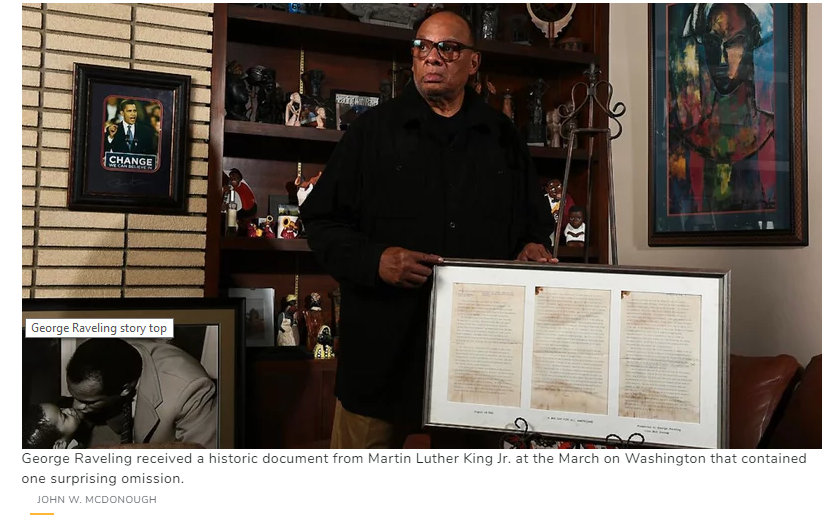
The story of how George Raveling, former men’s basketball coach at the University of Iowa, is intertwined with Martin Luther King Jr.’s famous “I Have a Dream” speech. Photo credit: Sports Illustrated
The Iowa connection
One more thing–there is a remarkable Iowa connection to this powerful story. It involves legendary basketball coach George Raveling, who coached men’s basketball at the University of Iowa in the 1980s. He has a copy of the famous speech, given to him by Martin Luther King, Jr. himself after the he delivered his immortal words on the steps of the Lincoln Memorial.
The story was retold in “Pioneering coach George Raveling’s surprising connection to MLK,” which ran in a 2015 issue of Sports Illustrated. Here’s a snippet:
“There is, however, one souvenir so special that Raveling stores it separately, at a secure location. The item is worth millions of dollars, but he will not sell it. It is too -important — to him, to his race and to his country.
Raveling acquired his most prized possession on Aug. 28, 1963, while standing on the steps of the Lincoln Memorial. Perhaps you recall what occurred on that date at that place: the March on Washington for Jobs and Freedom, the demonstration that culminated in a defining moment for the civil rights movement. Raveling didn’t decide to go to the march until two days before, yet he emerged from that trip with the three pieces of paper that lay on the podium while the final speaker delivered one of the most important addresses in U.S. history.
To understand how Raveling ended up next to the speaker, and why he refuses to cash in on his priceless memento, you have to rummage through his collection, run your finger along the road map and piece together the parallel lives of two men, one a preacher, the other a coach. Theirs is a story of history and happenstance, linked by a surreal moment that sprang from a dream.”
Read the rest of the story–and the all-important Iowa connection–here.
Want more?
Thanks for stopping by. I invite you to read more of my blog posts if you value intriguing Iowa stories and history, along with Iowa food, agriculture updates, recipes and tips to make you a better communicator.
If you like what you see and want to be notified when I post new stories, be sure to click on the “subscribe to blog updates/newsletter” button at the top of this page, or click here. Feel free to share this with friends and colleagues who might be interested, too.
Also, if you or someone you know could use my writing services (I’m not only Iowa’s storyteller, but a professionally-trained journalist with 20 years of experience), let’s talk. I work with businesses and organizations within Iowa and across the country to unleash the power of great storytelling to define their brand and connect with their audience through clear, compelling blog posts, articles, news releases, feature stories, newsletter articles, social media, video scripts, and photography. Learn more at www.darcymaulsby.com, or e-mail me at yettergirl@yahoo.com.
If you’re hungry for more stories of Iowa history, check out my top-selling “Culinary History of Iowa: Sweet Corn, Pork Tenderloins, Maid-Rites and More” book from The History Press. Also take a look at my latest book, “Dallas County,” and my Calhoun County” book from Arcadia Publishing. Both are filled with vintage photos and compelling stories that showcase he history of small-town and rural Iowa. Order your signed copies today! Iowa postcards are available in my online store, too.
Let’s stay in touch. I’m at darcy@darcymaulsby.com, and yettergirl@yahoo.com.
Talk to you soon!
Darcy
@Copyright 2019 Darcy Maulsby & Co. Blog posts may only be reprinted with permission from Darcy Maulsby.

Stop Rumors Before They Ruin Your Brand
Seriously–how does this stuff get started?
Like many of you, one of my goals for 2019 has been to focus on wellness, and that includes more exercise. Since options are limited here in snowy, cold Iowa in the winter, I’m glad there’s an indoor swimming pool nearby that’s open to the public a few hours a day.
I was swimming with some of my friends this morning, and one of them asked, “Have you sent that email yet?” I didn’t know what she was talking about, and she said she’s trying to encourage people who use the pool to let the facility’s administrator let know how much the community values the pool and how we don’t want it to close.
Turns out there’s a rumor swirling around that the cost of maintaining the pool might be prompting people in charge of the facility to close the pool. Distressing information, indeed.
I was glad when another one of my friends (one who works at the facility) stopped by to said hi while I was in the water. I asked if the talk about closing the pool was true.
“Where did you hear that?”
We told her the rumor was going around town. “No, this pool is important,” she said. “We have no plans to close it down.”
Not only was I relieved, but I started thinking about another conversation I had at the pool this morning. One of my friends brought up the name of the administrator of a large organization in town–but she admitted she wasn’t sure what the lady’s name was. Smith? Jones? Not sure.
All of us in the pool agreed that we knew little about this person. We also agreed how important it is for an organization (and those who lead it) to remain visible and keep the lines of communication open.
I wonder how many rumors, snippets of misinformation and flat-out lies could be countered effectively if people–especially business leaders–would stay in touch regularly with employees, customers, prospects, donors, the media and other key audiences. I’m not talking about a once-and-done approach, either.
In my experience, the best approach involves an ongoing commitment to sharing true stories well told through blog posts, e-newsletters, magazine articles, social media posts, videos and more) to add value for your audience. Along the way, you establish yourself as a trusted leader.
It’s an approach worth considering, especially in a world where a lie told often enough tends to become the truth.
Want more?
Thanks for stopping by. I invite you to read more of my blog posts if you value intriguing Iowa stories and history, along with Iowa food, agriculture updates, recipes and tips to make you a better communicator.
If you like what you see and want to be notified when I post new stories, be sure to click on the “subscribe to blog updates/newsletter” button at the top of this page, or click here. Feel free to share this with friends and colleagues who might be interested, too.
Also, if you or someone you know could use my writing services (I’m not only Iowa’s storyteller, but a professionally-trained journalist with 20 years of experience), let’s talk. I work with businesses and organizations within Iowa and across the country to unleash the power of great storytelling to define their brand and connect with their audience through clear, compelling blog posts, articles, news releases, feature stories, newsletter articles, social media, video scripts, and photography. Learn more at www.darcymaulsby.com, or e-mail me at yettergirl@yahoo.com.
If you’re hungry for more stories of Iowa history, check out my top-selling “Culinary History of Iowa: Sweet Corn, Pork Tenderloins, Maid-Rites and More” book from The History Press. Also take a look at my latest book, “Dallas County,” and my Calhoun County” book from Arcadia Publishing. Both are filled with vintage photos and compelling stories that showcase he history of small-town and rural Iowa. Order your signed copies today! Iowa postcards are available in my online store, too.
Let’s stay in touch. I’m at darcy@darcymaulsby.com, and yettergirl@yahoo.com.
Talk to you soon!
Darcy
@Copyright 2019 Darcy Maulsby & Co. Blog posts may only be reprinted with permission from Darcy Maulsby.
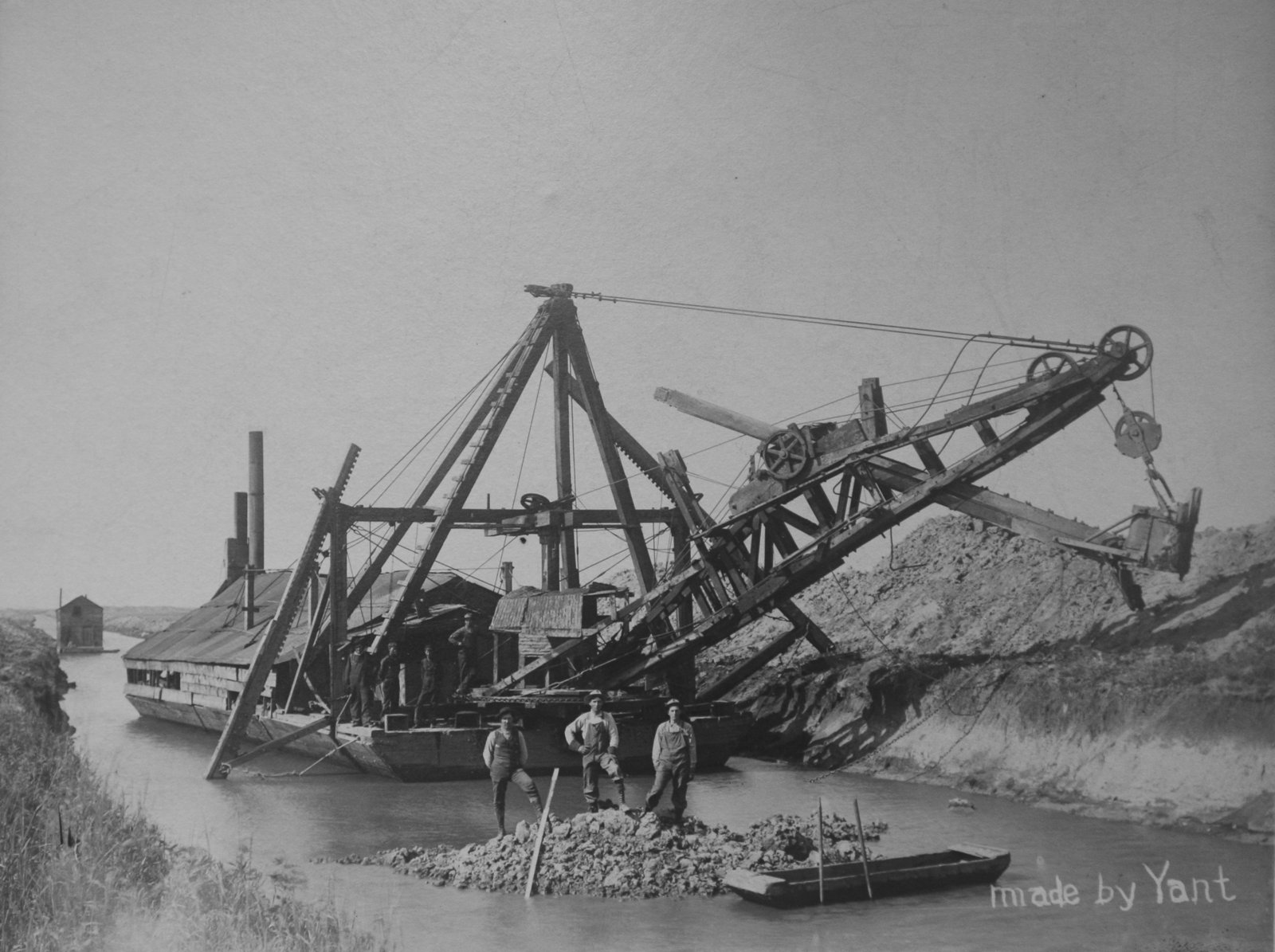
The Untold Story of Iowa’s Ag Drainage Systems
If there were a “Mysteries at the Museum” television series geared towards agriculture, this item would be ideal to lead in a segment. It’s hollow, it’s made of clay, it contains a message from the past, and it was buried in the ground for decades.
It’s a unique clay drainage tile dated 1885, and it’s on display in the Greene County Historical Society’s museum in Jefferson. The message carved around the exterior of the tile reads, “We the men who started the tile work did so with a motive to benefit the town and country. Signed T.P. LaRue of Scranton, Iowa.”
An interpretive sign by the tile shares a quote from S.J. Melson, a former Greene County engineer, to explain the curious item’s history. “This tile was placed into my hands by Carl Paup on February 1968. Mr. Paup stated the tile was unearthed and has lasted for many years on the property owned and operated by Harrison Paup of Kendrick Township, Greene County, Iowa.”
That tile reflects a major part of Iowa’s agricultural history that has been buried, literally, for generations, yet this history continues to influence farming methods, especially in the prairie pothole regions of north-central Iowa and northwest Iowa.
“In general, ag drainage in Iowa got its start around 1880, but this varied a lot, depending on the region,” said Joe Otto, a historian and Ph.D. candidate at the University of Oklahoma who works as a communications specialist with the Iowa Water Center at Iowa State University.
The first documented case of a drain tile being installed in Iowa occurred in 1868 on the grounds of Iowa State in Ames, Otto added. Before that, some of the first drainage ditches were dug in the 1850s along the Mississippi River in Des Moines County, just upstream from Burlington, so farmers could help protect themselves from flooding. One of these farmers, John Williams, was later elected to the state legislature and helped get the state’s first drainage laws passed in the 1870s, Otto said.
Drainage affected Iowa’s settlement patterns
Ag drainage was such a major issue in the 1800s that it impacted Iowa’s settlement. “Iowa wasn’t settled east to west, but from the bottoms up to the top of the state’s many river valleys,” Otto said. “Atop the river valleys were the flat, glaciated prairies of north-central and northwestern Iowa. These were settled and farmed starting in the 1870s and 1880s – several decades after farming started along the Mississippi.”
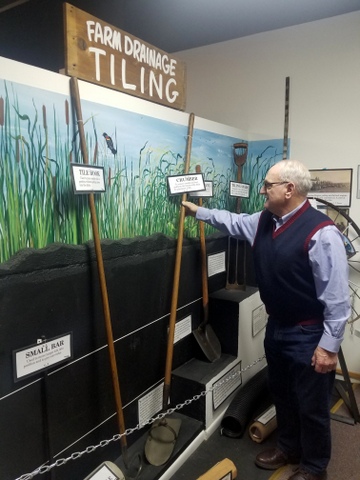
Jim Andrew revisits the exhibit designed by his father, James H. Andrew, a long-time Greene County farmer. This Farm Drainage Tiling exhibit is housed at the Greene County Historical Society’s museum in Jefferson, Iowa.
The region’s extensive swamps and sloughs were remnants of the last glacier, which loosened its icy grip on Iowa approximately 12,000 years ago. “There was a lot of water and nowhere for it to go,” Otto said. “Drainage ditches had to be dug and tile lines had to be laid before the sloughs and swamps of Iowa could be farmed. This started around 1880 and picked up speed in the early 1900s as drainage technology became more advanced.”
Ag leaders like Civil War veteran and pioneer farmer Jesse Allee, who settled in the Newell area in 1871, knew ag drainage would be essential to the development and prosperity of the region. “He was far-seeing with the unshakable belief in the future of the community’s farm land,” stated the 1969 Newell centennial history book on display at the Allee Mansion south of Newell. “Jesse worked hard educating the public to the necessity of proper drainage if this area was to be a leader in agriculture.”
Settlers in Greene County faced a similar situation. “By 1880, many landowners realized underground drainage tile was needed to remove the excess water,” wrote James H. Andrew, a long-time Greene County farmer who created the Farm Drainage Tiling exhibit at the Greene County Historical Society’s museum
in Jefferson before he passed away in 2014.
As more settlers moved into Iowa and demand for tile drainage grew, tile kilns and factories popped up across the state, Otto noted. Greene County, like many Iowa counties, had multiple firms manufacturing clay tile. These businesses used locally-sourced clay, including the Jefferson Cement Products Co., which was located just north of the Greene County Fairgrounds and operated until about 1930, and Lawton and Mass, which produced concrete tile at Cooper for a number of years, starting in 1895.
“There were also small machines made for farmers to mix concrete and scoop it into a manually-cranked device that used metal forms to make various sizes of tile,” wrote Andrew, who was known as “Mr. History.” “They advertised you could make your tile at home for half the cost of commercial tile. But it’s doubtful if this was very successful, since the proper steaming and curing of concrete tiles is important.”
Drainage districts take shape
Ag drainage in Iowa took a major leap forward in 1904, when state legislation provided for the formation of drainage districts. “Farmers could always drain their own lands if they wanted to, but to truly manage drained water meant cooperation with your neighbors,” Otto said.
A group of farmers could petition for a drainage district. An engineer would survey the land to establish the boundaries of the area, and a feasible drainage plan would be developed.
If approved, a contract would be drawn up, with the cost paid by assessing each landowner for his or her fair share, considering his needs and the acres involved. The county acted as the administrator of the drainage district and assessed taxes against the land, as needed, to pay for the initial cost and later for the maintenance of the drainage district. Many times, the money would be borrowed by issuing bonds, and the landowners would make payments on a 10-year plan, Andrew noted.
“The drainage district plan provided the larger tile needed for the main arteries of the system,” Andrew wrote. “Individual landowners were responsible for installing and paying for the lateral tile lines installed on their respective farms to complete the drainage plan.”
From 1904 to 1919, an average of 10 new drainage districts were created per year in Greene County. “That’s a new district about every five weeks,” Andrew wrote.
The 1910s became the golden age of ag drainage when most of Iowa’s public drainage systems were built, Otto added. “By 1912, Iowa’s farmers had spent more money on drainage then the U.S. government spent to build the Panama Canal.”
A Greene County drainage district created in 1916 to drain 998.7 acres using approximately 3.5 miles of tile ranging in size from 10 inches to 22 inches cost of $9,135, [more than $218,640 in today’s dollars], said Michelle Fields, drainage clerk for Greene County. “A drainage district created and installed in 2013 drained 865.5 acres using around 2.38 miles of tile ranging in size from 15 to 24 inches at a cost $532,500,” she added.
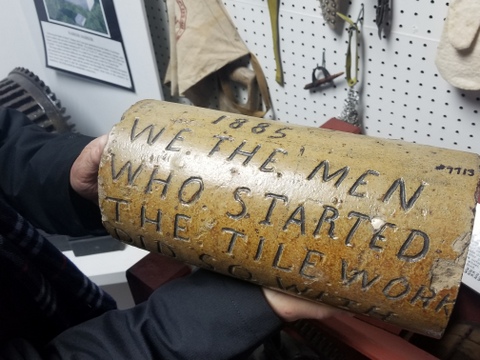
This unique clay ag drainage tile dated 1885 is on display in the Greene County Historical Society’s museum in Jefferson. The message carved around the exterior of the tile reads, “We the men who started the tile work did so with a motive to benefit the town and country. Signed T.P. LaRue of Scranton, Iowa.”
Recalling the life of a ditch digger
By 1920, the formation of ag drainage districts in Iowa slowed down as the post-World War 1 ag depression hit rural America. Still, the work continued.
“Steam power (and later gasoline) engines moved steel and iron machines that could move a lot more dirt around than could horse-drawn scrapers and plows,” Otto said.
Around 1923, after most Greene County drainage districts were in place, the first tiling machines started to be used, although hand digging continued for many years, Andrew noted. In the spring, summer and fall, men could find a job “in the ditch” if they wanted to work. “Many immigrants coming to the USA found their first jobs digging canals, and later drainage ditches. You didn’t have to know English to be a good man in the ditch,” added Andrew, who noted that many of these workers were from Sweden and Ireland.
The early tilers typically lived in tents or small, portable shacks next to the wet land they were draining. They often cooked their own meals and lived off the land by catching frogs for fried frogs’ legs and snapping turtles for turtle soup. They shot ducks, geese and rabbits for meat. Sometimes bullheads and other fish could be caught in the larger ponds, Andrew noted. For water, including drinking water, the men would take a post auger and dig a hole 3 to 4 feet deep and would set in an old farm pump.
“Ditch digging was well organized, and the men were paid by the rods of ditch dug by each man,” Andrew wrote. “No work—no pay. And of course, workmen’s compensation, health insurance and so on were unheard of.”
“Generous gifts”
By the 1970s, corrugated plastic pipe was introduced, which gradually phased out clay tile as the most efficient way to drain land. Today, Greene County has nearly 3,000 miles of drainage district tile and pipes, ranging from 4 inches to 48 inches in diameter. This distance would roughly equal a tile ditch spanning from New York to San Francisco.
“Note that the 3,000 miles is just a measure of the district tiles,” Fields said. “That number would be exponentially larger if you included private tile lines.”
As ag drainage issues have increasingly become intertwined with debates about conservation and water quality, it’s important to keep the line of communication open, Otto said.
“I think the harsh reaction against ag drainage that’s happened in the past few years is due in part to people suddenly wanting to engage in drainage matters, but unsure of what drainage is and does, who administers it and what powers they have. On the other side of the coin, the people trusted to manage the public’s interests in drainage have a responsibility to break down barriers, explain misconceptions and guide the conversation to a common ground.”
That’s a big reason why Andrew documented the history of ag tiling, counting it as one of the most important events in local history and the settlement of the region, noted his son, Jim Andrew of Jefferson.
“Think of the men and the effort it took to dig the clay, form and cure the tile, haul the tile to the jobsite, the survey crews working in ponds and swamps, the drainage plans made by the drainage engineer proving drainage was practical, the legal problems of objections and disputes, letting the bids, and, most important, the hundreds of men with strong backs who worked digging the ditches, laying the tile and filling the ditches,” wrote James H. Andrew.
“Yet, the tile is hidden underground, and the ‘Iron Men’ tilers are all deceased,” he concluded. “As time passes, there is little appreciation for the cooperative efforts that drained Greene County and made it so productive. Only when these old tile systems fail and have to be replaced at great expense will many people realize the generous gifts we’ve received from the drainage district system.”
Want more?
Thanks for stopping by. I invite you to read more of my blog posts if you value intriguing Iowa stories and history, along with Iowa food, agriculture updates, recipes and tips to make you a better communicator.
If you like what you see and want to be notified when I post new stories, be sure to click on the “subscribe to blog updates/newsletter” button at the top of this page, or click here. Feel free to share this with friends and colleagues who might be interested, too.
Also, if you or someone you know could use my writing services (I’m not only Iowa’s storyteller, but a professionally-trained journalist with 20 years of experience), let’s talk. I work with businesses and organizations within Iowa and across the country to unleash the power of great storytelling to define their brand and connect with their audience through clear, compelling blog posts, articles, news releases, feature stories, newsletter articles, social media, video scripts, and photography. Learn more at www.darcymaulsby.com, or e-mail me at yettergirl@yahoo.com.
If you’re hungry for more stories of Iowa history, check out my top-selling “Culinary History of Iowa: Sweet Corn, Pork Tenderloins, Maid-Rites and More” book from The History Press. Also take a look at my latest book, “Dallas County,” and my Calhoun County” book from Arcadia Publishing. Both are filled with vintage photos and compelling stories that showcase he history of small-town and rural Iowa. Order your signed copies today! Iowa postcards are available in my online store, too.
Let’s stay in touch. I’m at darcy@darcymaulsby.com, and yettergirl@yahoo.com.
Talk to you soon!
Darcy
@Copyright 2019 Darcy Maulsby & Co. Blog posts may only be reprinted with permission from Darcy Maulsby.
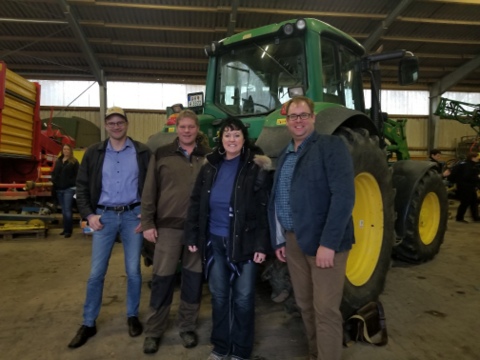
Ag-Vocating Worldwide: Top 10 Tips for Sharing Ag’s Story with Consumers
Any of these sound familiar? Many consumers today don’t understand modern agriculture. Activists are spreading misinformation about farming. Myths about farming seem to carry more weight than facts. I couldn’t believe what I was hearing. While these things are top of mind for me here in Iowa, they’re hot topics in Germany and across Europe, too.
So what do you do about it? We shared best practices when I joined five other ag leaders from Iowa in northern Germany to meet with European farmers, veterinarians and other ag professionals during the Transatlantic Agricultural Dialogue on Consumer Engagement from November 11-16, 2018.
“This experience highlighted why we must make time to share the what and why of how we do things on the farm,” said my friend Chad Ingels, a farmer from Randalia, Iowa, who participated in the Germany study trip, which was supported by the German-American Chamber of Commerce. “Consumers around the world really have no idea what happens in the day-to-day activities on the farm. We need to share our story and keep it simple, without using ‘farmer jargon.’”
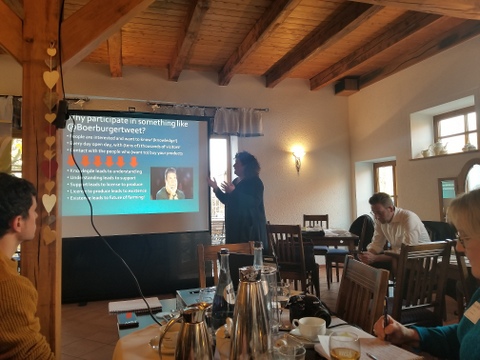
Learning practical tips in Germany for telling ag’s story effectively
Ingels, who raises corn, soybeans and hogs and is active on social media, appreciated the opportunity to exchange practical ideas to address the public’s questions about food production. During these discussions, ag leaders from both sides of the Atlantic shared their 10 top tips for engaging with consumers, including:
1. Be willing to engage. Who is telling agriculture’s story, and what are they saying? Don’t leave it to chance, said Caroline van der Plas from the Netherlands, who encourages farmers to build relationships and share their story with consumers, the media and lawmakers. “If you don’t share your story, others like People for the Ethical Treatment of Animals (PETA) will tell it for you,” said van der Plas, who coordinates the Dutch social media project @boerburgertweet, which allows farmers to share their story with consumers on Twitter.
The ripple effect from one story can be powerful, noted Janice Person, online engagement director for Bayer CropScience. She credits one interview more than 20 years ago with Louisiana farmer Ray Young for motivating her to pursue an agricultural communications career. “I was a city girl from Memphis who was interested in ecology,” said Person, keynote speaker at the Transatlantic Agricultural Dialogue on Consumer Engagement. “When I interviewed Ray Young, he had me so focused on his soils that I can still see them in my mind. He explained conservation tillage and helped me understand how he was getting it to work on his farm. By taking the time to tell his story, Ray helped me become an influencer for agriculture.”
2. Look at ag through consumers’ eyes. Empathy matters. People don’t care how much you know until they know how much you care, Person said. “Many people today are hearing things about food and agriculture that scare them. Sometimes people are angry, sometimes they are confused and sometimes they want to listen.” Most people just want what’s best for their families, added Person, who noted that farmers can bring a valuable, real-world perspective to the conservation.
3. Tell a different side of the story. While most consumers have heard a lot about organic farming, they rarely hear about other types of production. “It’s easy for people to think there’s only one side of the story or one way to farm, unless you share a different perspective,” Person said.
4. Focus on the moveable middle. Activists are loud, but they are still a minority, said Nadine Henke, an ag-vocate from Germany. “There are still a lot of people in the middle, but few really understand modern agriculture. We can reach out to them.”

Farmer Derek from Kansas and his trombone, calling the cows
5. Find inspiring ag-vocates. There are many ag-vocates to follow online, from Dirt Sweat N Tears (@farmermegzz on Twitter), a film industry specialist turned farmer from Saskatchewan, Canada, to Derek Klingenberg (@Farmer Derek on Twitter), a Kansas farmer and rancher whose popular YouTube videos range from him playing his trombone to call his cows to a video of a college choir singing in his new grain bin. “We have different crops and livestock and various ways of farming, so our stories are all different,” Person said. “What ag-vocates have in common is their decision to tell their story and make a positive impact.”
6. Never underestimate face-to-face conversations. While social media gets a lot of attention, it’s not the only place to tell ag’s story, Person said. “Some of the most important conservations still take place in person.”
7. Show how technology can be part of the solution. “Most people like to be modern,” Person said. Share the story of modern ag by showing how technology is helping protect the environment with solutions like precision spraying. “People love to discover things,” Person said. “They don’t like to be lectured to. Sharing knowledge can create a sense of wonder.”
8. Stay on track. Challenge people and encourage them to think about a different viewpoint, but always be respectful of your audience, Person said. “Be careful about going on defense too soon. Also, make time to explain not just the how, but why you do what you do on the farm.” Don’t stop with posting pictures, she added. Share your stories of the land and what you think is special about your region. If you have livestock, explain the how and why of manure management. If you like to cook, showcase seasonal foods and recipes. In any case, don’t devote too much time to people who aren’t willing to listen and only want to argue, Caroline van der Plas added. “The longer you engage with activists, the less time you have to tell your story.”
9. Build trust. What’s the ultimate goal of telling ag’s story? Building trust. “It’s all relationship based, and trusted relationships are so important,” Person said.
10. Take the long view. Communication is never a once-and-done deal. It’s an ongoing process. “What can you do in the next year, and the next five years, to tell your ag story?” Person asked. Also, remember that you’re not alone. “Sometimes food and farming issues feel so polarized that it’s easy to forget other people are saying the same things we are,” Person said. “It’s incredibly rewarding to reach out with ag’s story. Know that there is power in coming together.”
So here I am back home in rural Iowa, trying to implement these 10 tips, starting with this article, which originally appeared in Farm News and the Fort Dodge Messenger. I’d love to hear from you, too. In your experience, what works well to share your story effectively?
Want more?
Thanks for stopping by. I invite you to read more of my blog posts if you value intriguing Iowa stories and history, along with Iowa food, agriculture updates, recipes and tips to make you a better communicator.
If you like what you see and want to be notified when I post new stories, be sure to click on the “subscribe to blog updates/newsletter” button at the top of this page, or click here. Feel free to share this with friends and colleagues who might be interested, too.
Also, if you or someone you know could use my writing services (I’m not only Iowa’s storyteller, but a professionally-trained journalist with 20 years of experience), let’s talk. I work with businesses and organizations within Iowa and across the country to unleash the power of great storytelling to define their brand and connect with their audience through clear, compelling blog posts, articles, news releases, feature stories, newsletter articles, social media, video scripts, and photography. Learn more at www.darcymaulsby.com, or e-mail me at yettergirl@yahoo.com.
If you’re hungry for more stories of Iowa history, check out my top-selling “Culinary History of Iowa: Sweet Corn, Pork Tenderloins, Maid-Rites and More” book from The History Press. Also take a look at my latest book, “Dallas County,” and my Calhoun County” book from Arcadia Publishing. Both are filled with vintage photos and compelling stories that showcase he history of small-town and rural Iowa. Order your signed copies today! Iowa postcards are available in my online store, too.
Let’s stay in touch. I’m at darcy@darcymaulsby.com, and yettergirl@yahoo.com.
Talk to you soon!
Darcy
@Copyright 2018 Darcy Maulsby & Co. Blog posts may only be reprinted with permission from Darcy Maulsby.
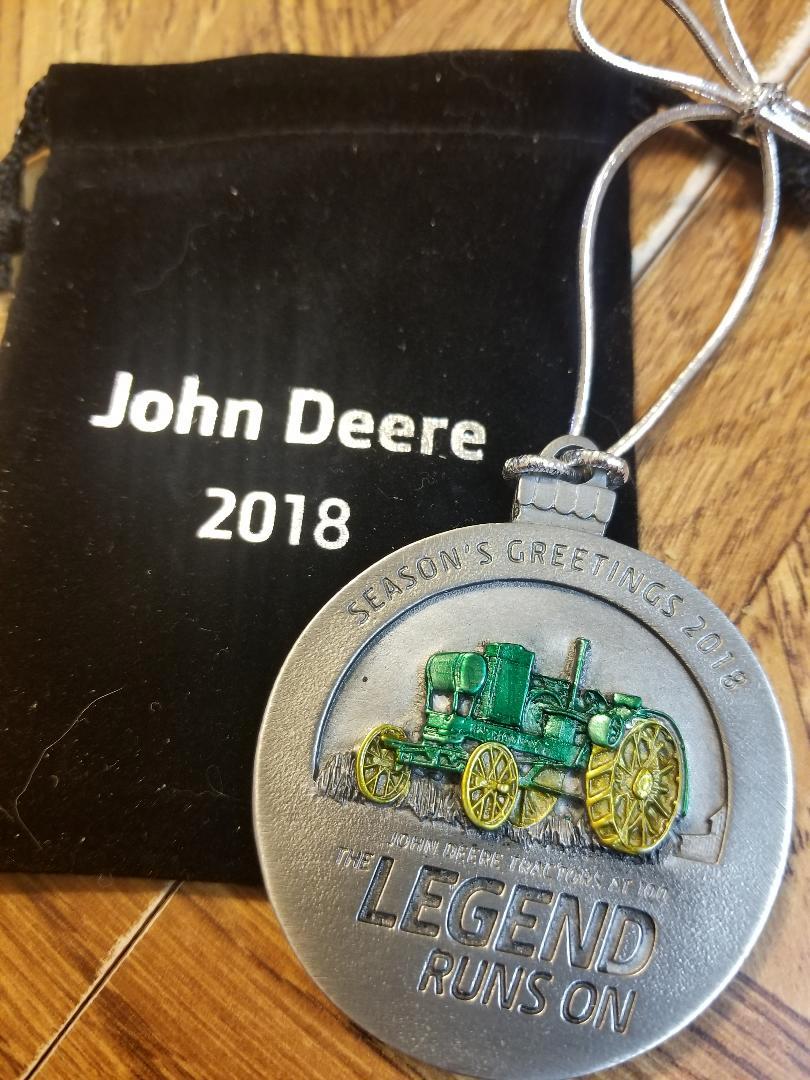
Butter Sculptures to Christmas Ornaments: Waterloo Boy Tractor Celebrates 100 Years
It’s hard to imagine a time when John Deere wasn’t a powerhouse in the tractor business. Yet, John Deere wouldn’t enter the farm tractor business until March 1918 through the acquisition of the Waterloo Gasoline Engine Company, and it’s a milestone that has been commemorated in everything from butter to Christmas ornaments.
Deere has featured a picture and story depicting the 100th anniversary of the iconic Waterloo Boy on its 2018 Christmas ornament. The 2018 Iowa State Fair also honored the tractor by featuring the world-famous Butter Cow beside a butter sculpture of the Waterloo Boy. Both butter masterpieces were displayed in the 114-year old John Deere Agriculture Building’s 40-degree cooler throughout the fair, which ran from August 9-19.
The Iowa State Fair has long been a prime venue to display Deere equipment in its various forms. A quote from the John Deere Sales Department in 1940 read, “I feel that the machinery and industrial exhibits for 1940 excelled any previous year’s display,” according to history shared by the Iowa State Fair. “We consider our Iowa State Fair exhibit to be a very beneficial part of our advertising program, and we will be with you again in 1941.’”
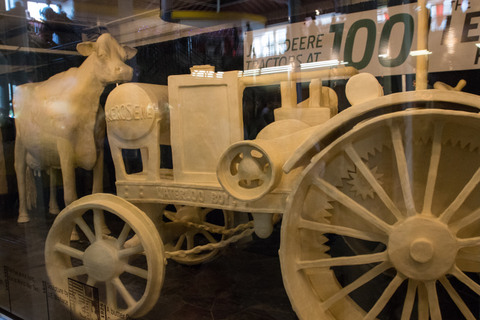
Waterloo Boy butter sculpture 2018 Iowa State Fair
Meeting the challenge of a reliable, durable tractor
Frequently ranked as one of the top events in the country, the Iowa State Fair is the single largest event in the state of Iowa and one of the oldest and largest agricultural expositions in the country and annually attracts more than a million people from all over the world.
In 2018, the Iowa State Fair used more than 50 John Deere tractors and utility vehicles provided by Van Wall Equipment. In addition, a 1919 Waterloo Boy model N tractor was on display in the Machinery Grounds at the Iowa State Fair.
To understand the significance of the Waterloo Boy, take a trip back in time, said Neil Dahlstrom, manager of the John Deere Archives and History. In the critical five-year stretch (1912-1917) prior to John Deere entering the tractor business, there were two key issues the company needed answered.
“First, what did farmers really want from a machine that would soon make the horse obsolete?” said Dahlstrom, who noted that salesmen, territory and branch managers, and Deere’s top leadership scoured the country to understand what customers desired.
Also, how could the equipment to be manufactured to be durable enough to stand up to daily farm use?
Deere had considered every imaginable idea. The company had developed one-, two- and four-cylinder concept tractors. Some ran on gasoline. Others ran on kerosene. Some had all-wheel drive. Others had front-wheel drive. The company even explored concepts like line steering, which was meant to replicate horse reins as the steering mechanism to ease farmers into power farming, Dahlstrom said.
A motorized cultivator, what Deere called a “Tractivator,” was brought to market by several competitors, but Deere determined it did not provide any cost savings compared to horses.
The challenge of producing a durable tractor loomed large. In a letter to company president William Butterworth in 1915, Deere’s superintendent of factories George Mixter noted that tractors offered by competitors up to that point “have not been built with the proper spirit behind the design and manufacture to insure their durability in the hands of the farmers.” But if Deere could “build a small tractor that will really stand up for five or more years’ work on the farm, I believe they will be a permanent requirement of the American farmer,” Mixter wrote.
Deere ultimately found the solution with the Waterloo Boy tractor and acquired the Waterloo Gasoline Engine Company in Waterloo, Iowa, on March 14, 1918. Although anxious to start selling the Waterloo Boy, Deere dealers had to wait while Deere honored existing contracts, which did not expire until Dec. 31, 1918, Dahlstrom said.
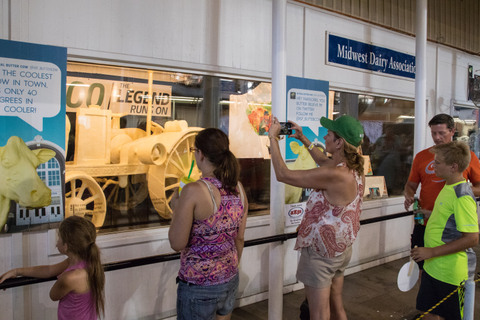
Visitors snapped photos of the iconic Waterloo Boy butter sculpture 2018 Iowa State Fair.
Waterloo Boy makes its debut
Deere put its money where its instincts were. Over the next year, the company spent more than one-third of its advertising budget touting the Waterloo Boy tractor, Dahlstrom said.
Specifically, Deere invested $50,000 on tractor advertising in the year following its debut of the Waterloo Boy—approximately $747,000 in today’s money. Another way to get the company’s new product out in front of customers was to take it on the road – literally.
The National Tractor Demonstrations started to become more mainstream after being introduced in the United States in 1913. An eight-city, eight-week tour schedule was the perfect opportunity to unveil Deere’s Waterloo Boy, Dahlstrom said. Salina, Kansas, served as the ideal backdrop in August 1918, since this was the nation’s largest demonstration.
Deere had participated in tractor demonstrations since the original Winnipeg Agricultural Motor Competitions in Manitoba, Canada, in 1908 – but not with a tractor. Instead, Deere had paired its plows with leading tractor manufacturers. That changed now that the Waterloo Boy was part of the Deere family.
At Salina, Deere spared no expense, showcasing 12 Waterloo Boy tractors as the centerpiece of a display that included John Deere signs, Waterloo Boy signs and a copper leaping deer statue, Dahlstrom said. “There were two stars during this week of 100-degree days – ‘ice water on tap’ and the Waterloo Boy Model ‘N’ tractor,” he added.
The Model “N” demonstrated its merits by pulling tractor plows, disc harrows and grain drills. Visitors were shuttled in three John Deere farm wagons pulled by Waterloo Boy tractors. By all accounts, the debut was a success.
“The award for the most elaborate, largest and most artistic exhibit tent at the Salina tractor show will undoubtedly go to the John Deere Plow company of Kansas City,” wrote the editors of a Kansas City newspaper.
As Deere’s advertising campaign swung into full gear, the Waterloo Boy tractor was promoted as the “best and most efficient tractor” on the market for farmers inclined to buy a tractor. By October 1918, readers of Deere’s magazine, The Furrow, saw an advertisement for the line of Waterloo Boy tractors and stationary engines. The ad guaranteed the Waterloo Boy’s “ample power for field and belt work.”
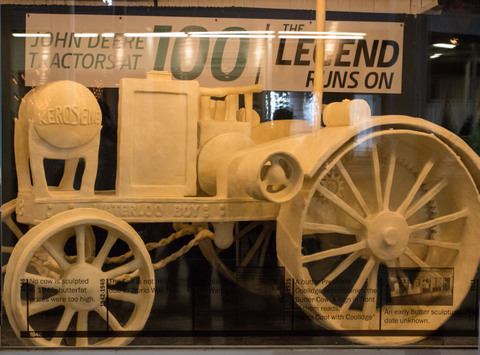
Waterloo Boy butter sculpture 2018 Iowa State Fair
In January 1919, with tractors now available through John Deere dealers, Deere’s first print ad for the trade press appeared in The Farm Implement News. It featured two areas of emphasis: “A Good Tractor Backed by a Permanent Organization.”
After years of development, John Deere customers and John Deere dealers finally had their John Deere tractor.
“It took longer than the company expected, but a determination to do it right instead of doing it fast now brought the John Deere tractor to market,” Dahlstrom said.
As a result, customers got “the assurance of more tractor work per dollar of fuel cost; longer tractor life with less repair cost; accessibility of parts that makes caring for the tractor simple and easy; and dependable power for all farm work.”
The tractor era had officially arrived.
Want more?
Thanks for stopping by. I invite you to read more of my blog posts if you value intriguing Iowa stories and history, along with Iowa food, agriculture updates, recipes and tips to make you a better communicator.
If you like what you see and want to be notified when I post new stories, be sure to click on the “subscribe to blog updates/newsletter” button at the top of this page, or click here. Feel free to share this with friends and colleagues who might be interested, too.
Also, if you or someone you know could use my writing services (I’m not only Iowa’s storyteller, but a professionally-trained journalist with 20 years of experience), let’s talk. I work with businesses and organizations within Iowa and across the country to unleash the power of great storytelling to define their brand and connect with their audience through clear, compelling blog posts, articles, news releases, feature stories, newsletter articles, social media, video scripts, and photography. Learn more at www.darcymaulsby.com, or e-mail me at yettergirl@yahoo.com.
If you’re hungry for more stories of Iowa history, check out my top-selling “Culinary History of Iowa: Sweet Corn, Pork Tenderloins, Maid-Rites and More” book from The History Press. Also take a look at my latest book, “Dallas County,” and my Calhoun County” book from Arcadia Publishing. Both are filled with vintage photos and compelling stories that showcase he history of small-town and rural Iowa. Order your signed copies today! Iowa postcards are available in my online store, too.
Let’s stay in touch. I’m at darcy@darcymaulsby.com, and yettergirl@yahoo.com.
Talk to you soon!
Darcy
@Copyright 2018 Darcy Maulsby & Co. Blog posts may only be reprinted with permission from Darcy Maulsby.


